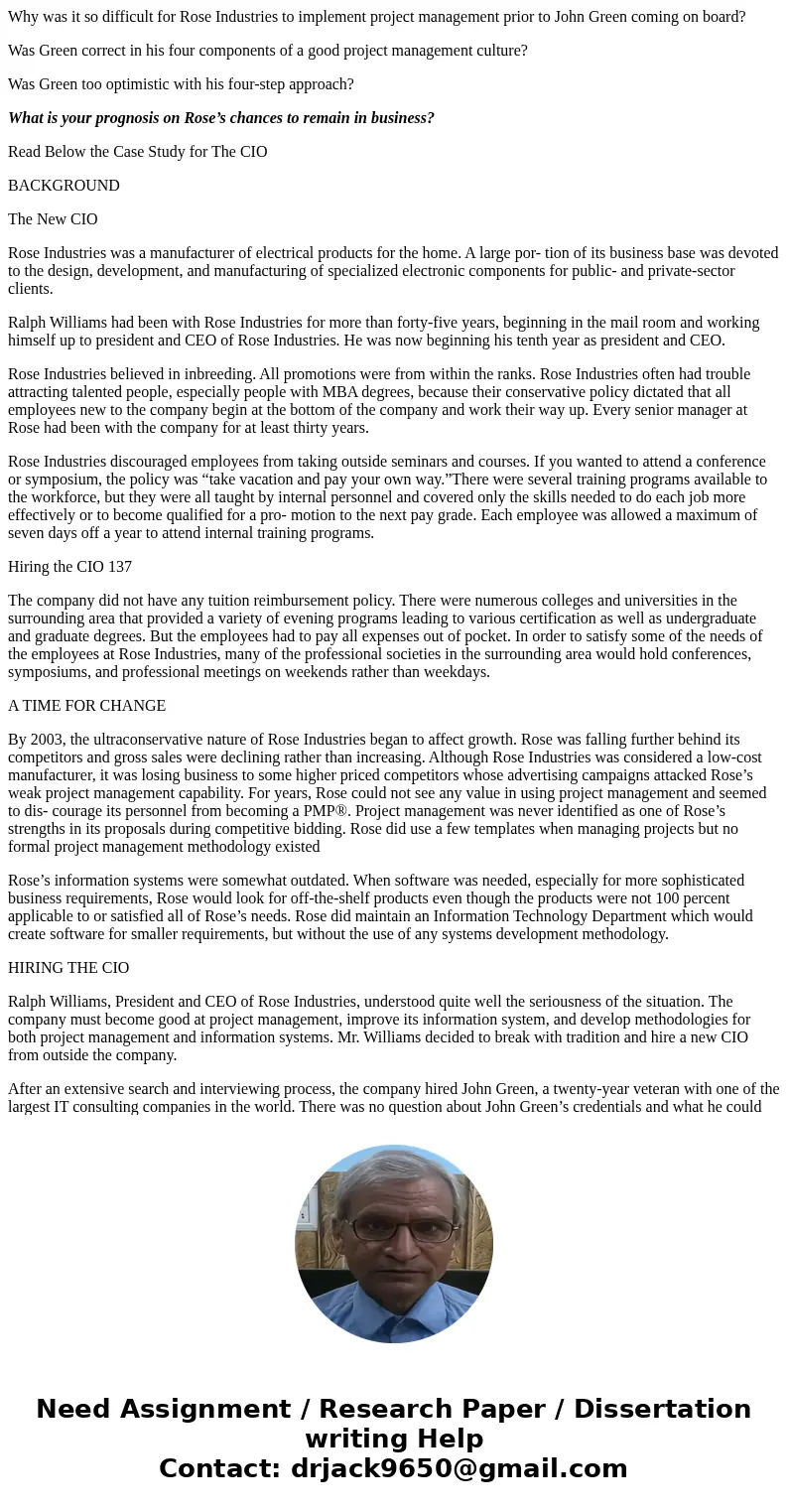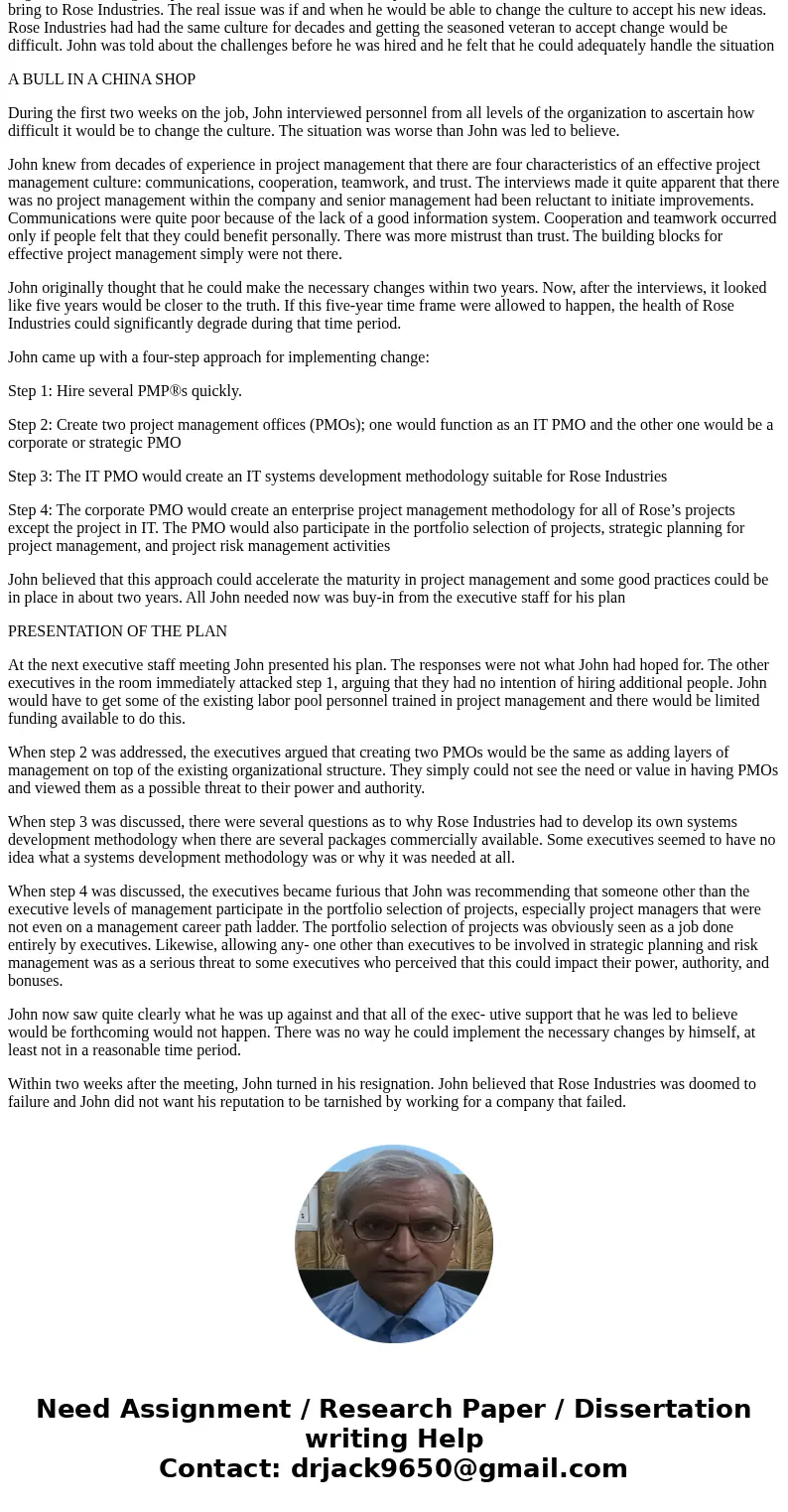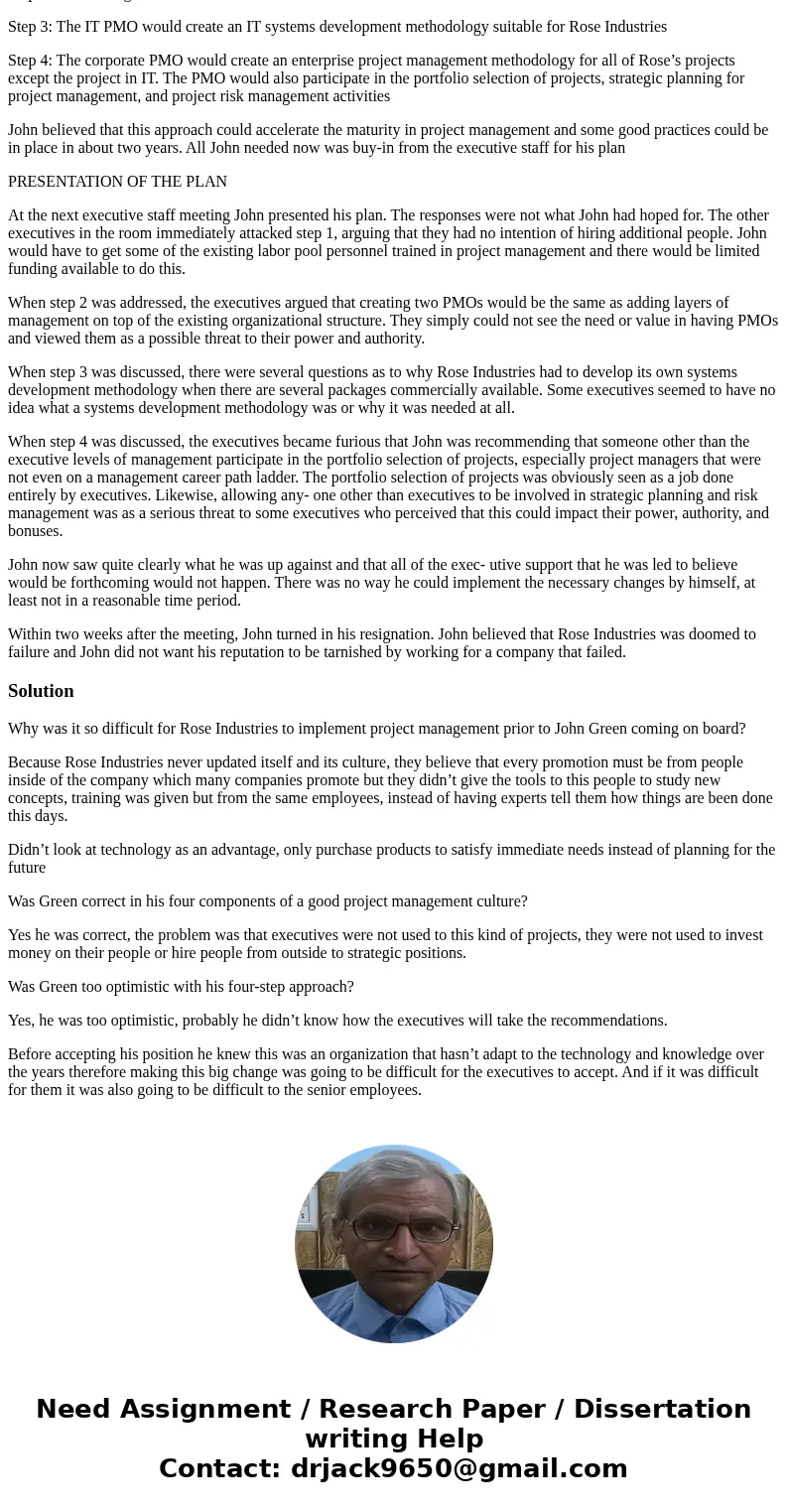Why was it so difficult for Rose Industries to implement pro
Why was it so difficult for Rose Industries to implement project management prior to John Green coming on board?
Was Green correct in his four components of a good project management culture?
Was Green too optimistic with his four-step approach?
What is your prognosis on Rose’s chances to remain in business?
Read Below the Case Study for The CIO
BACKGROUND
The New CIO
Rose Industries was a manufacturer of electrical products for the home. A large por- tion of its business base was devoted to the design, development, and manufacturing of specialized electronic components for public- and private-sector clients.
Ralph Williams had been with Rose Industries for more than forty-five years, beginning in the mail room and working himself up to president and CEO of Rose Industries. He was now beginning his tenth year as president and CEO.
Rose Industries believed in inbreeding. All promotions were from within the ranks. Rose Industries often had trouble attracting talented people, especially people with MBA degrees, because their conservative policy dictated that all employees new to the company begin at the bottom of the company and work their way up. Every senior manager at Rose had been with the company for at least thirty years.
Rose Industries discouraged employees from taking outside seminars and courses. If you wanted to attend a conference or symposium, the policy was “take vacation and pay your own way.”There were several training programs available to the workforce, but they were all taught by internal personnel and covered only the skills needed to do each job more effectively or to become qualified for a pro- motion to the next pay grade. Each employee was allowed a maximum of seven days off a year to attend internal training programs.
Hiring the CIO 137
The company did not have any tuition reimbursement policy. There were numerous colleges and universities in the surrounding area that provided a variety of evening programs leading to various certification as well as undergraduate and graduate degrees. But the employees had to pay all expenses out of pocket. In order to satisfy some of the needs of the employees at Rose Industries, many of the professional societies in the surrounding area would hold conferences, symposiums, and professional meetings on weekends rather than weekdays.
A TIME FOR CHANGE
By 2003, the ultraconservative nature of Rose Industries began to affect growth. Rose was falling further behind its competitors and gross sales were declining rather than increasing. Although Rose Industries was considered a low-cost manufacturer, it was losing business to some higher priced competitors whose advertising campaigns attacked Rose’s weak project management capability. For years, Rose could not see any value in using project management and seemed to dis- courage its personnel from becoming a PMP®. Project management was never identified as one of Rose’s strengths in its proposals during competitive bidding. Rose did use a few templates when managing projects but no formal project management methodology existed
Rose’s information systems were somewhat outdated. When software was needed, especially for more sophisticated business requirements, Rose would look for off-the-shelf products even though the products were not 100 percent applicable to or satisfied all of Rose’s needs. Rose did maintain an Information Technology Department which would create software for smaller requirements, but without the use of any systems development methodology.
HIRING THE CIO
Ralph Williams, President and CEO of Rose Industries, understood quite well the seriousness of the situation. The company must become good at project management, improve its information system, and develop methodologies for both project management and information systems. Mr. Williams decided to break with tradition and hire a new CIO from outside the company.
After an extensive search and interviewing process, the company hired John Green, a twenty-year veteran with one of the largest IT consulting companies in the world. There was no question about John Green’s credentials and what he could bring to Rose Industries. The real issue was if and when he would be able to change the culture to accept his new ideas. Rose Industries had had the same culture for decades and getting the seasoned veteran to accept change would be difficult. John was told about the challenges before he was hired and he felt that he could adequately handle the situation
A BULL IN A CHINA SHOP
During the first two weeks on the job, John interviewed personnel from all levels of the organization to ascertain how difficult it would be to change the culture. The situation was worse than John was led to believe.
John knew from decades of experience in project management that there are four characteristics of an effective project management culture: communications, cooperation, teamwork, and trust. The interviews made it quite apparent that there was no project management within the company and senior management had been reluctant to initiate improvements. Communications were quite poor because of the lack of a good information system. Cooperation and teamwork occurred only if people felt that they could benefit personally. There was more mistrust than trust. The building blocks for effective project management simply were not there.
John originally thought that he could make the necessary changes within two years. Now, after the interviews, it looked like five years would be closer to the truth. If this five-year time frame were allowed to happen, the health of Rose Industries could significantly degrade during that time period.
John came up with a four-step approach for implementing change:
Step 1: Hire several PMP®s quickly.
Step 2: Create two project management offices (PMOs); one would function as an IT PMO and the other one would be a corporate or strategic PMO
Step 3: The IT PMO would create an IT systems development methodology suitable for Rose Industries
Step 4: The corporate PMO would create an enterprise project management methodology for all of Rose’s projects except the project in IT. The PMO would also participate in the portfolio selection of projects, strategic planning for project management, and project risk management activities
John believed that this approach could accelerate the maturity in project management and some good practices could be in place in about two years. All John needed now was buy-in from the executive staff for his plan
PRESENTATION OF THE PLAN
At the next executive staff meeting John presented his plan. The responses were not what John had hoped for. The other executives in the room immediately attacked step 1, arguing that they had no intention of hiring additional people. John would have to get some of the existing labor pool personnel trained in project management and there would be limited funding available to do this.
When step 2 was addressed, the executives argued that creating two PMOs would be the same as adding layers of management on top of the existing organizational structure. They simply could not see the need or value in having PMOs and viewed them as a possible threat to their power and authority.
When step 3 was discussed, there were several questions as to why Rose Industries had to develop its own systems development methodology when there are several packages commercially available. Some executives seemed to have no idea what a systems development methodology was or why it was needed at all.
When step 4 was discussed, the executives became furious that John was recommending that someone other than the executive levels of management participate in the portfolio selection of projects, especially project managers that were not even on a management career path ladder. The portfolio selection of projects was obviously seen as a job done entirely by executives. Likewise, allowing any- one other than executives to be involved in strategic planning and risk management was as a serious threat to some executives who perceived that this could impact their power, authority, and bonuses.
John now saw quite clearly what he was up against and that all of the exec- utive support that he was led to believe would be forthcoming would not happen. There was no way he could implement the necessary changes by himself, at least not in a reasonable time period.
Within two weeks after the meeting, John turned in his resignation. John believed that Rose Industries was doomed to failure and John did not want his reputation to be tarnished by working for a company that failed.
Solution
Why was it so difficult for Rose Industries to implement project management prior to John Green coming on board?
Because Rose Industries never updated itself and its culture, they believe that every promotion must be from people inside of the company which many companies promote but they didn’t give the tools to this people to study new concepts, training was given but from the same employees, instead of having experts tell them how things are been done this days.
Didn’t look at technology as an advantage, only purchase products to satisfy immediate needs instead of planning for the future
Was Green correct in his four components of a good project management culture?
Yes he was correct, the problem was that executives were not used to this kind of projects, they were not used to invest money on their people or hire people from outside to strategic positions.
Was Green too optimistic with his four-step approach?
Yes, he was too optimistic, probably he didn’t know how the executives will take the recommendations.
Before accepting his position he knew this was an organization that hasn’t adapt to the technology and knowledge over the years therefore making this big change was going to be difficult for the executives to accept. And if it was difficult for them it was also going to be difficult to the senior employees.



 Homework Sourse
Homework Sourse